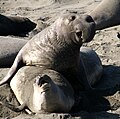Top Qs
Timeline
Chat
Perspective
Copulation (zoology)
Animal sexual reproductive act in which a male introduces sperm into the female's body From Wikipedia, the free encyclopedia
Remove ads
In zoology, copulation is animal sexual behavior in which a male introduces sperm into the female's body, especially directly into the female's reproductive tract.[1][2] This is an aspect of mating. Many aquatic animals use external fertilization, whereas internal fertilization may have developed from a need to maintain gametes in a liquid medium in the Late Ordovician epoch.[citation needed] Internal fertilization with many vertebrates (such as all reptiles, some fish, and most birds) occurs via cloacal copulation, known as cloacal kiss (see also hemipenis), while most mammals copulate vaginally, and many basal vertebrates reproduce sexually with external fertilization.[3][4]
Remove ads
In spiders and insects
Summarize
Perspective
Spiders are often confused with insects, but they are not insects; instead, they are arachnids.[5][6] Spiders have separate male and female sexes. Before mating and copulation, the male spider spins a small web and ejaculates on to it. It then stores the sperm in reservoirs on its large pedipalps, from which it transfers sperm to the female's genitals. The females can store sperm indefinitely.[7]

For primitive insects, the male deposits spermatozoa on the substrate, sometimes stored within a special structure; courtship involves inducing the female to take up the sperm package into its genital opening, but there is no actual copulation.[8][9] In groups that have reproduction similar to spiders, such as dragonflies, males extrude sperm into secondary copulatory structures removed from their genital opening, which are then used to inseminate the female. In dragonflies, it is a set of modified sternites on the second abdominal segment.[10] In advanced groups of insects, the male uses its aedeagus, a structure formed from the terminal segments of the abdomen, to deposit sperm directly (though sometimes in a capsule called a spermatophore) into the female's reproductive tract.[11]
Remove ads
In mammals
Summarize
Perspective
Mating postures of mammals
Sexual behavior can be classified into behavioral states associated with reward motivation ("wanting"), reward consummation also known as pleasure ("liking"), and satiety ("inhibition");[12] these behavioral states are regulated in mammals by reward-based sexual learning, fluctuations in various neurochemicals (i.e., dopamine − sexual desire also known as "wanting"; norepinephrine − sexual arousal; oxytocin and melanocortins − sexual attraction), and gonadal hormone cycles and further influenced by sex pheromones and motor reflexes (i.e., lordosis behaviour) in some mammals.[12][13]
These behavioral states correlate with the phases of the human sexual response cycle: motivation − excitement; consummation − plateau and orgasm; satiety − refraction.[12] Sexual learning (a form of associative learning) occurs when an animal starts to associate bodily features, personality, contextual cues, and other stimuli with genitally-induced sexual pleasure.[12][13] Once formed, these associations in turn impinge upon both sexual wanting and sexual liking.
In most female mammals, the act of copulation is controlled by several innate neurobiological processes, including the motor sexual reflex of lordosis.[14] In males, the act of copulation is more complex, because some learning is necessary, but the innate processes (retrocontrol of penis intromission in the vagina, rhythmic movement of the pelvis, detection of female pheromones) are specific to copulation. These innate processes direct heterosexual copulation.[15] Female lordosis behaviour became secondary in Hominidae and is non-functional in humans.[16] Mammals usually copulate in a dorso-ventral posture, although some primate species copulate in a ventro-vental posture.[17][18]
Most mammals possess a vomeronasal organ that is involved in pheromone detection, including sex pheromones.[19] Despite the fact that humans do not possess this organ, adult humans appear to be sensitive to certain mammalian pheromones that putative pheromone receptor proteins in the olfactory epithelium are capable of detecting.[note 1][19] While sex pheromones clearly play a role in modifying sexual behavior in some mammals, the capacity for general pheromone detection and the involvement of pheromones in human sexual behavior has not yet been determined.[12]
The duration of copulation varies significantly between mammal species,[23] and may be correlated with body mass, lasting longer in large mammals than in small mammals.[24] The duration of copulation may also be correlated with the length of the baculum in mammals.[25]
Male mammals ejaculate semen through the penis into the female reproductive tract during copulation.[26][27] Ejaculation usually occurs after only one intromission in humans, canids, and ungulates, but occurs after multiple intromissions in most mammal species.[28][29]
Copulation can induce ovulation in mammal species that do not ovulate spontaneously.[30]
- Copulating brown bears
- Copulating lions
- Copulating grey kangaroos
- Copulating Aldabra giant tortoises
- Copulating Magellanic penguins
Remove ads
See also
Notes
- In humans and other animals, trace amine-associated receptors (TAARs) that are expressed in the olfactory epithelium function as olfactory receptors that detect volatile amine odorants, including certain pheromones;[20][21] these TAARs putatively function as a class of pheromone receptors involved in the olfactive detection of social cues.[20][21]
A review of studies involving non-human animals indicated that TAARs in the olfactory epithelium can mediate attractive or aversive behavioral responses to an agonist.[20] This review also noted that the behavioral response evoked by a TAAR can vary across species.[20] For example, TAAR5 mediates attraction to trimethylamine in mice and aversion to trimethylamine in rats.[20] In humans, hTAAR5 presumably mediates aversion to trimethylamine, which is known to act as an hTAAR5 agonist and to possess a foul, fishy odor that is aversive to humans;[20][22] however, hTAAR5 is not the only olfactory receptor that is responsible for trimethylamine olfaction in humans.[20][22] As of December 2015,[update] hTAAR5-mediated trimethylamine aversion has not been examined in published research.[22]
Remove ads
References
Bibliography
Wikiwand - on
Seamless Wikipedia browsing. On steroids.
Remove ads












